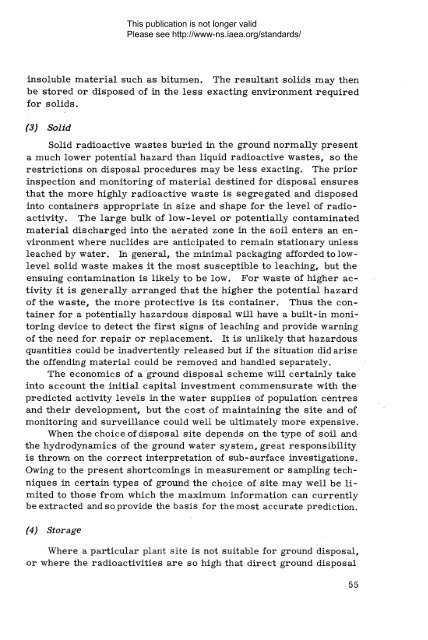Safety_Series_015_1965 - gnssn - International Atomic Energy ...
Safety_Series_015_1965 - gnssn - International Atomic Energy ...
Safety_Series_015_1965 - gnssn - International Atomic Energy ...
Create successful ePaper yourself
Turn your PDF publications into a flip-book with our unique Google optimized e-Paper software.
This publication is not longer validPlease see http://www-ns.iaea.org/standards/insoluble material such as bitumen. The resultant solids may thenbe stored or disposed of in the less exacting environment requiredfor solids.(3) SolidSolid radioactive wastes buried in the ground normally presenta much lower potential hazard than liquid radioactive wastes, so therestrictions on disposal procedures may be less exacting. The priorinspection and monitoring of material destined for disposal ensuresthat the more highly radioactive waste is segregated and disposedinto containers appropriate in size and shape for the level of radioactivity.The large bulk of low -level or potentially contaminatedmaterial discharged into the aerated zone in the soil enters an environmentwhere nuclides are anticipated to remain stationary unlessleached by water. In general, the minimal packaging afforded to lowlevelsolid waste makes it the most susceptible to leaching, but theensuing contamination is likely to be low. For waste of higher activityit is generally arranged that the higher the potential hazardof the waste, the more protective is its container. Thus the containerfor a potentially hazardous disposal will have a built-in monitoringdevice to detect the first signs of leaching and provide warningof the need for repair or replacement. It is unlikely that hazardousquantities could be inadvertently released but if the situation did arisethe offending material could be removed and handled separately.The economics of a ground disposal scheme will certainly takeinto account the initial capital investment commensurate with thepredicted activity levels in the water supplies of population centresand their development, but the cost of maintaining the site and ofmonitoring and surveillance could well be ultimately more expensive.When the choice of disposal site depends on the type of soil andthe hydrodynamics of the ground water system, great responsibilityis thrown on the correct interpretation of sub-surface investigations.Owing to the present shortcomings in measurement or sampling techniquesin certain types of ground the choice of site may well be limitedto those from which the maximum information can currentlybe extracted and so provide the basis for the most accurate prediction.(4) StorageWhere a particular plant site is not suitable for ground disposal,or where the radioactivities are so high that direct ground disposal55
















